Content [show]
Coniferous evergreen fir has long settled in our parks and garden plots. The scent of fir cannot be confused with any other, the delicate, but persistent aroma invigorates and fills with strength. In nature, fir trees grow for up to 200 years, giving seeds annually, but fir trees can also reproduce at home. A distinctive feature that allows you to immediately identify a fir is the cones, like candles, growing upward on wide flat branches.
What does a fir look like
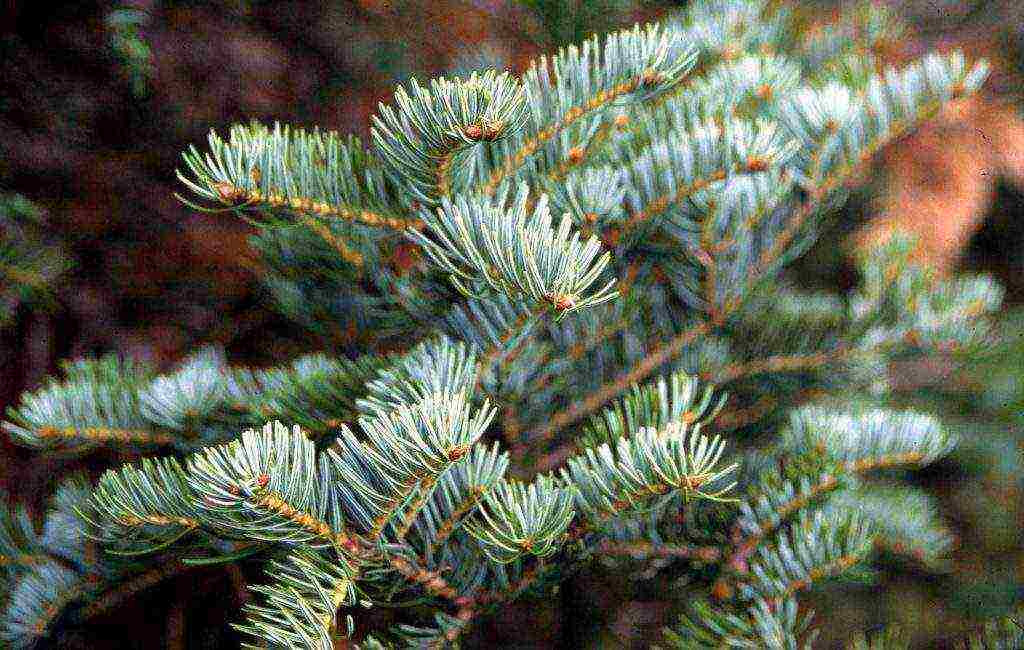 Fir needles are soft, absolutely not prickly, but soft
Fir needles are soft, absolutely not prickly, but soft
An amazing tree - fir! This coniferous plant differs in many ways from its counterparts.
A slender cone-shaped trunk is visible from afar, bearing horizontal branches with dense dark green needles. The tree can grow up to 50 m in height, while the trunk is up to half a meter in diameter. Unlike other conifers, fir branches are arranged in a circle, forming regular rings.
The bark is light yellow, dense, in places it forms thickenings where the transparent resin is located. But wood has structural features, it does not have resin passages, traditional for conifers, resin is formed exclusively in the bark.
Even the needles of the fir are not the same as those of the spruce or pine, but flat, flattened. On it, cones grow vertically upward, which have female and male spikelets. Fir blossoms and bears fruit after 30 years.
Fir structure
The fir habitat is wide: from tropical latitudes to the Arctic Circle. But most species are thermophilic plants with low frost resistance. For fir to grow well, fertile moist soil is required, but trees do not like direct sun, being extremely shade-tolerant, for example, whole-leafed.
Fir has a variety of useful properties, and the use of this was found in medicine even in Ancient Russia and the North American Indians. Contains a large amount of resin, which has antibacterial properties. Therefore, young fir is almost not susceptible to disease. Fir essential oil is an important component in the production of medicines, it helps with many diseases, like a decoction from needles, bark or resin.
 Fir essential oil has a healing, anti-inflammatory, disinfecting effect
Fir essential oil has a healing, anti-inflammatory, disinfecting effect
Types and varieties of fir
Biologists describe more than 50 types of fir, it is excellent for decorative purposes, because:
- grows symmetrically;
- the needles crumble imperceptibly and the tree does not look bald;
- the needles are soft and not prickly;
- the branches are nicely arranged in a circle.
Siberian fir (ordinary)
Common fir is most common in the north of Russia, therefore its second name is Siberian. The deep root system allows the tall tree, up to 40 m, to withstand strong winds. Lives up to 200 years and dies from root rot. It tolerates cold well, but air pollution affects it negatively.
 The structure of Siberian fir
The structure of Siberian fir
Korean fir (Silberlok)
The Korean fir, or Koreana, is prized by landscape designers for its grace. Low, reaching a maximum of 15 m in height, the tree has a symmetrical dense crown. Unpretentious, grows well in the sun and in the shade. Smooth gray bark, dark green soft needles make fir a decoration of the park. It surprises the Koreans with cones that come in blue or reddish purple.
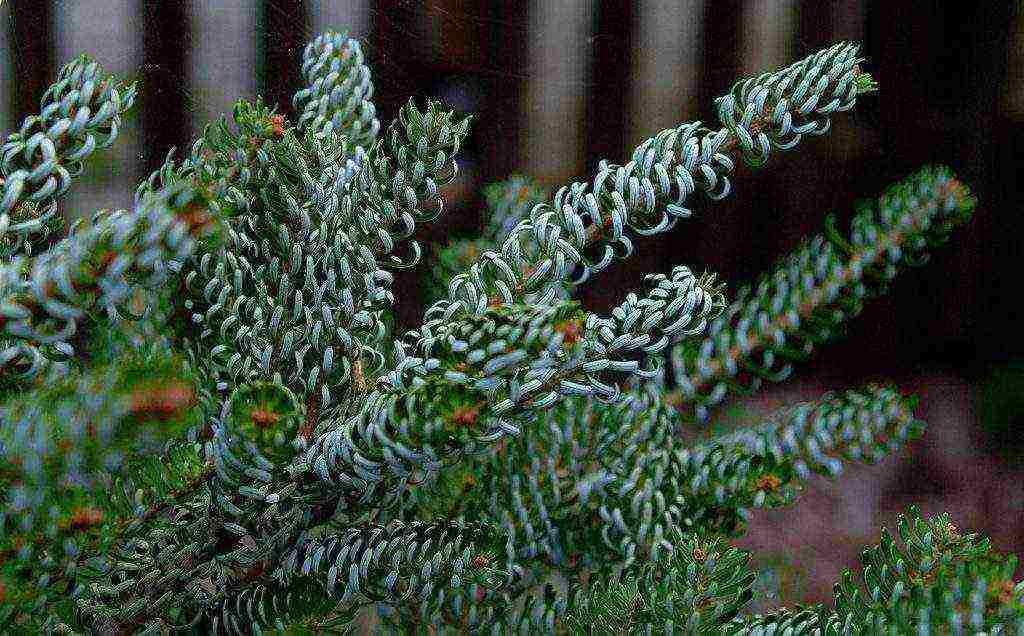 Korean fir has twisted needles
Korean fir has twisted needles
Natural habitat - Asia, primarily Korea.
Nordman fir (Caucasian)
The homeland of Nordman fir is the eastern Black Sea region, where it grows for 500 years, quickly reaching a height of 50 m. It is frost-resistant, shade-tolerant, but requires compliance with a certain air humidity. The trunk diameter is up to 2 m. The crown has a neat pyramidal shape, the needles are shiny. This ornate type of fir is used in Europe as a Christmas tree. Often used in landscaping.
 Caucasian fir is often used for landscaping
Caucasian fir is often used for landscaping
Balsam fir (nana)
In nature, balsam fir, or nana, is widely represented in North America, where it occupies vast areas. The tree lives 150-200 years, grows quickly, grows up to 25 m in height. Many decorative varieties have been bred; dwarf fir is especially popular. The buds are purple. The needles can be variegated or have white needle tips. Withstands light frosts and air pollution.
 Balsamic fir structure
Balsamic fir structure
Fir monochromatic
The monochromatic fir is widespread in the middle lane and is loved by decorators for its beauty and easy care. Not picky and growing:
- in dry areas;
- on any soils, up to slightly salted;
- resistant to winds and urban air pollution;
- tolerates frost.
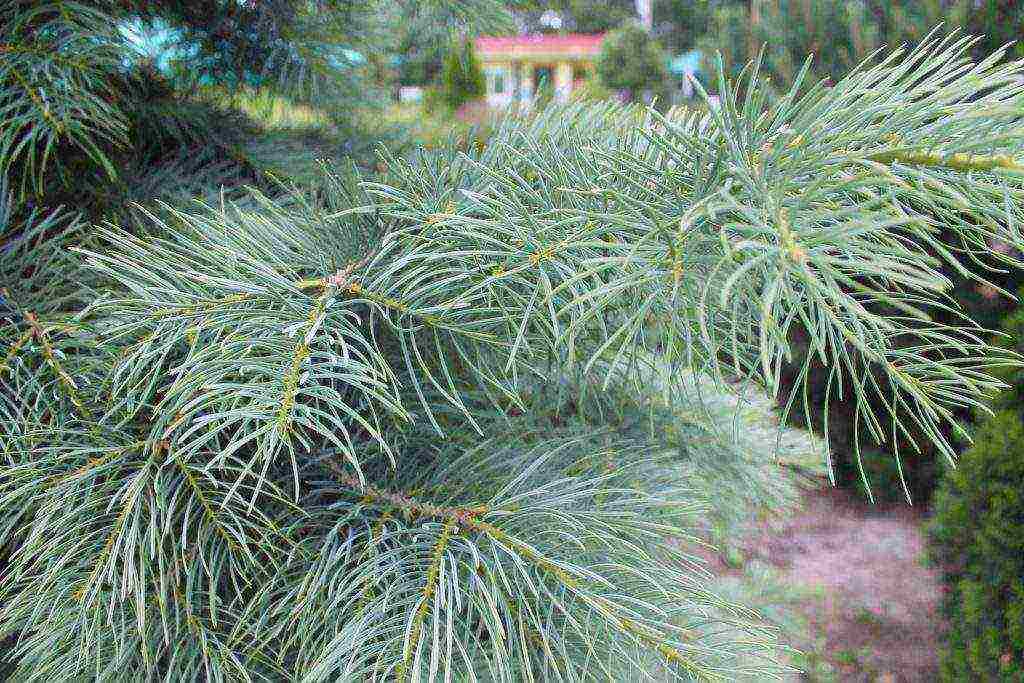 The single-color fir has a beautiful bluish tint.
The single-color fir has a beautiful bluish tint.
The tree grows up to 40 m, blue long large needles smell like lemon. Monochrome fir looks advantageous alone if the background for it is larch. There are many garden species, undersized and dwarf species are especially appreciated.
White fir (European, comb)
Distributed in central and southern Europe, because does not tolerate cold. It grows for 300-400 years, reaching a height of 65 m. For development, the tree requires moderately fertile moist soil, as well as clean moist air. In landscape design, it is more often used as a stock, since the decorative qualities of this type of fir are low: the tree has a loose crown, the trunk is quickly exposed.
 White fir also has other names: European, comb
White fir also has other names: European, comb
Fraser fir
The Fraser fir is loved to be used in America as a Christmas tree due to its thornless soft needles. The fir looks pretty:
- grows up to 15 m;
- correct conical crown;
- the gaps between the branches give lightness and volume;
- small buds are purple-brown with a purple tint.
 Fraser's fir is a great decoration for the New Year
Fraser's fir is a great decoration for the New Year
This type of fir can be grown in a pot, it will be a decoration of the garden.
Vicha fir
Grows naturally in the mountains of Japan. Vich mountain fir is a slender tree up to 40 m tall, with short branches forming a fluffy crown. Very popular for its shiny needles that have white stripes on the bottom. In windy weather, this gives the needles a silvery hue. It grows rapidly for 200-300 years, but it is demanding on light and soil fertility. The tree is frost-resistant, tolerates smoke and gas pollution well.
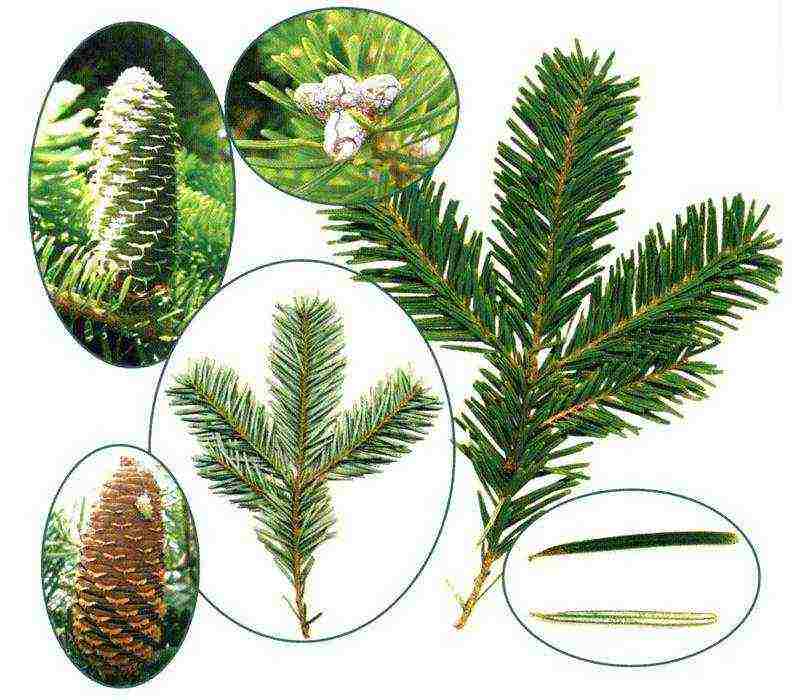 The structure of the Vich fir
The structure of the Vich fir
Subalpine compact fir (rough-fruited)
The rough fir grows in the mountains of North America, next to the white pine. It is rarely used as an ornamental plant due to its exactingness to natural conditions:
- the soil should be light, fertile, well moistened;
- growth is slow, reaching a maximum of 20 m in 200 years.
Differences of subalpine fir:
- the crown is narrow;
- the bark of old trees is cracked.
 Subalpine fir is called so because its homeland is the Alps.
Subalpine fir is called so because its homeland is the Alps.
Used for indoor cultivation as bonsai.
How to create ideal conditions for fir
Fir cannot be called a capricious and demanding plant; even an inexperienced gardener can grow it, following simple planting and care rules.
Advice! It is better to plant a fir immediately in the designated place - the tree does not like unnecessary transplants.
The soil
Fir species can grow well on a wide variety of soil types. However, there are general preferences:
- the soil should be fertile and light;
- on heavy clay soil, drainage is necessary in the form of fragments of bricks, rubble at the bottom of the pit;
- the earth should be moderately moist, but without stagnant moisture.
 When planting a fir seedling, it is necessary to provide a drainage layer
When planting a fir seedling, it is necessary to provide a drainage layer
The optimal composition of the soil when growing fir in the garden:
- leafy land;
- peat;
- sand;
- clay.
All components are taken in a 1: 1 ratio, except for clay, which requires 2 parts.
In order for the fir to grow well, the soil around the trunk must be loosened to a depth of 20-40 cm, removing weeds, and mulching. For this, sawdust, chips or peat are laid out with a layer of 5-8 cm under the trunk.
 You can fertilize a fir seedling using bark, ash and peat
You can fertilize a fir seedling using bark, ash and peat
Location
Like any coniferous plant, fir prefers to grow in darkened corners, although some varieties thrive in the sun. The choice of location depends on the type of tree. Fir trees love fresh air, and once rooted, they tolerate strong winds well. In a polluted area, the tree will hurt and grow poorly.
Watering
The planted fir is watered 1-2 times a month, so that the soil remains slightly moist. In the future, in central Russia, the tree has enough natural precipitation, additional watering is not required. In warmer climates, fir is watered several times during April-September during extreme heat. Watering will require 15-20 liters of water. But often it is impossible to water the tree, this will cause rotting of the roots. In case of drought, it is necessary to spray the tree every 2-3 weeks. To refresh the needles, the crown is sprayed with a hose.
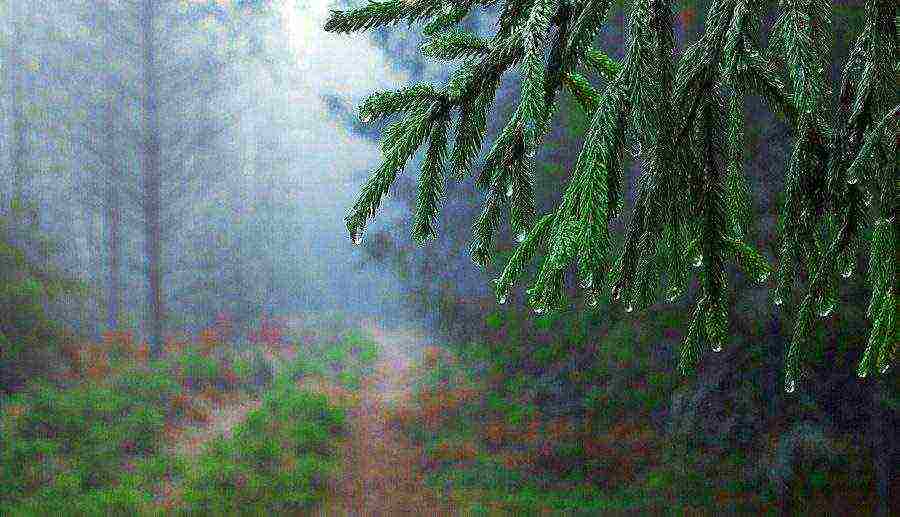 Fir has enough natural watering
Fir has enough natural watering
Top dressing
Fir feeding is done in 2-3 years. For fertilization, use "Kemir Universal" at the rate of 150 g per 1 m2 of the root circle of the tree. Top dressing is carried out in the spring.
Winter care
Although many varieties of fir are frost-resistant, it is better to cover young plantings in winter from bad weather. For warmth, the trees are covered with peat, dry leaves, spruce branches, but the branches of the fir itself cannot be used for these purposes. In the spring, the needles remaining on them will not let light and air through. An outward sign that the tree is freezing is that the needles turn red. After 5-7 years, fir ceases to be vulnerable to cold weather.
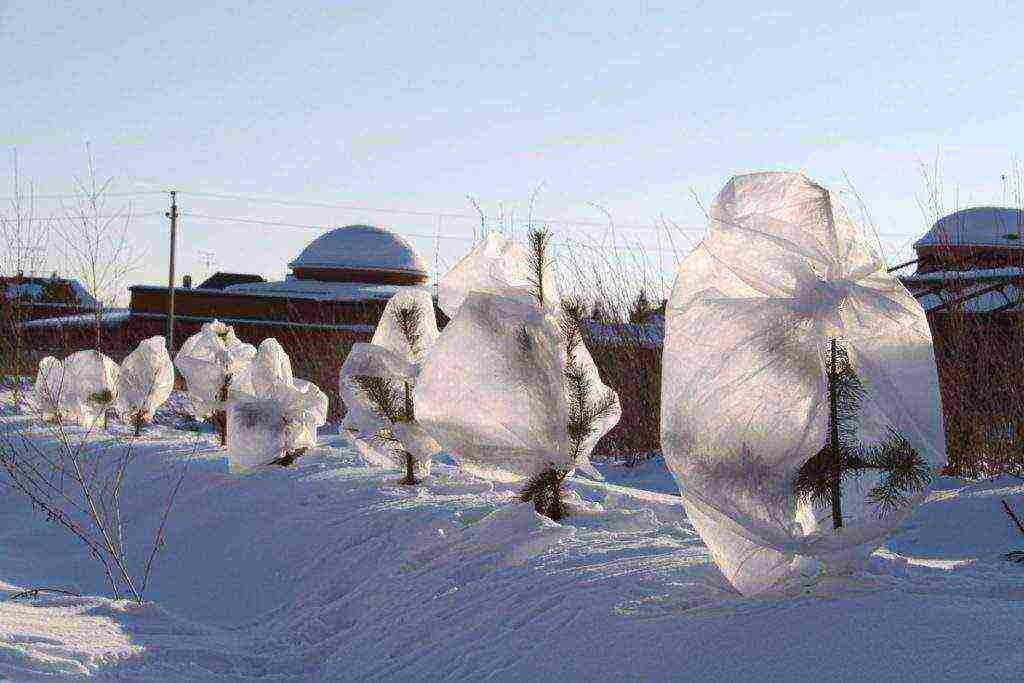 Small fir seedlings are covered for the winter until they get stronger
Small fir seedlings are covered for the winter until they get stronger
Crown pruning
Fir does not require regular pruning and crown formation. But in the spring, dried and diseased branches are removed, if desired, the crown is trimmed.
 Fir branches can dry out and must be removed.
Fir branches can dry out and must be removed.
Reproduction
Bloom
In nature, fir propagates by seeds. They are formed by pollination of female flowers in the form of standing cones with male ones, similar to earrings, it is difficult for a layman to see the moment of flowering. The seeds ripen the same year. Fir cones crumble, leaving only the stem on the branch, and the seeds scatter.
 Fir propagates by seeds, after opening the cones
Fir propagates by seeds, after opening the cones
Cuttings
In order for varietal firs to retain all decorative characteristics, they are propagated:
- layering;
- cuttings.
Layers are formed independently, without human intervention.In this case, the lower branches adhere so tightly to the ground that they take root after 1-2 years. But in ornamental gardening, this breeding method is inapplicable, because does not guarantee the formation of a symmetrical conical crown.
Reproduction by cuttings is more often used. In this case, a one-year-old branch with an apical bud:
- cut off;
- cleared from the bottom of the needles;
- for several hours placed in a slightly pink solution of potassium permanganate;
- deepens in the open field by 2-3 cm at an inclination of 300.
 Fir seedlings can be grown from cuttings
Fir seedlings can be grown from cuttings
Cuttings take root in 8-9 months. During the first 10 years, the seedlings grow very slowly, therefore it is preferable to use seedlings 6-10 years old.
Seeds
The collected seeds are sown either in the fall or in the spring after preparation. You can store them for a year. To obtain seedlings of specific fir, the seeds are processed:
- for a month they are placed in sand, perlite or a plastic bag, where the same level of humidity is maintained;
- sprouts that appear after 7-10 days are covered with fallen fir needles to maintain the humidity level;
- grown seedlings are planted in separate pots.
 Fir seedlings can be grown from seeds
Fir seedlings can be grown from seeds
Fir seedlings are transplanted into open ground after 4-5 years.
Attention! A sharp change in temperature conditions is undesirable: the seedlings must have time to adapt.
Correct seating of fir
Correct planting and a good location in the garden or in the summer cottage will show the beauty of the coniferous tree and create optimal conditions for growth and development.
Boarding time
Transplanting fir from a container into open ground can be carried out throughout the spring-autumn season. Planting of 5-10-year-old seedlings is done in April or September, choosing cloudy rainy days for this. Seedlings planted in autumn are covered with foliage or spruce branches for the winter.
How to plant
The parameters of the planting pit depend on the size of the root system; for 10-year-old seedlings, a hole is dug:
- width 50x50 cm;
- depth 50-80 cm;
- deeper by 10-15 cm, the earth is loosened.
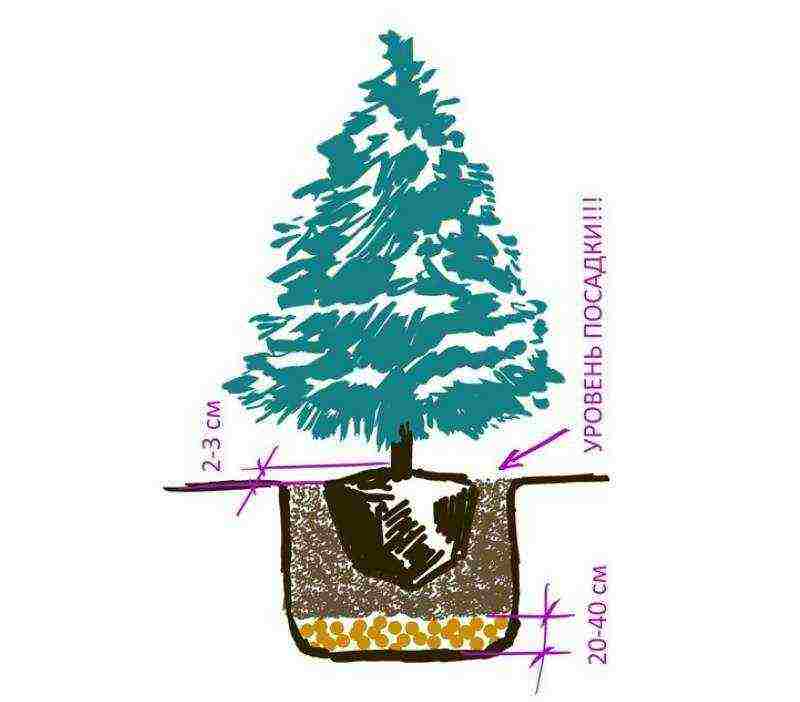 Fir seedling planting level
Fir seedling planting level
The pit is filled with:
- Half soil mixture consisting of:
- clay soil 2 parts;
- humus 3 parts;
- river sand 1 part;
- peat 1 part.
- A layer of 10 kg of sawdust and 200 g of fertilizer.
- Garden land.
The pit with the prepared soil mixture should stand for 2 weeks. When planting, the roots are straightened horizontally, the tree is dug in vertically. The root collar remains at ground level.
Location
Fir trees are planted in a different order, so as to emphasize the texture and beauty of the cone-shaped crown.
- Alley. The distance between the fir trees in a row is 4-5 m.
- Chess. Fir trees are planted in squares every 3 m.
- Group. A distance of 2.5-3.5 m is made between the trees.
Fir is also planted separately, in this case it must be surrounded by partner plants.
 Fir perfectly complements the landscape design of the site
Fir perfectly complements the landscape design of the site
Partner plants
Next to the dark green, silver or bluish fir needles, white-trunk birches, maples, a fir-tree, a juniper look interesting. Fir becomes a bright accent on the alpine slide. Shade-tolerant flowers are selected for the neighborhood. For contrast, flowering shrubs are placed next to the fir.
How to grow a fir at home
Fir growing is possible in an apartment, in a pot. Caring for a fir in a pot is no different from its larger relatives in the garden.
Pot selection
The choice of container depends on the height and type of fir. Korean fir or other dwarf varieties are more often used as bonsai. They require flat, low containers with drainage holes.
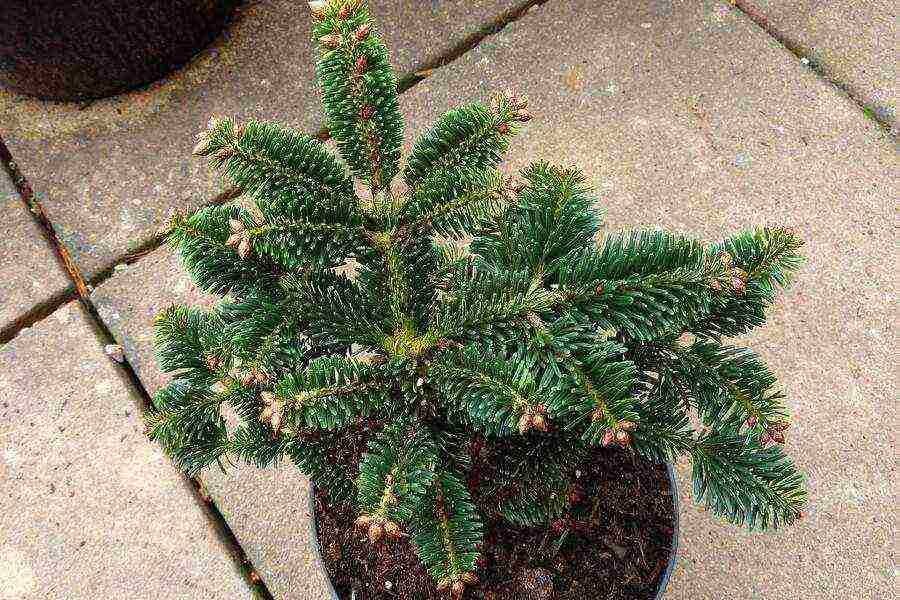 Small fir can be grown in a pot
Small fir can be grown in a pot
Soil and planting
Indoor fir is planted in the same soil mixture as garden and park. A drainage layer of gravel or brick chips is required. The transplant is carried out in spring or autumn.The earth lump is rolled into a new container, already half filled with soil mixture, the roots are straightened, sprinkled with earth on top, then 1-2 cm of sawdust.
Watering
The earthen compound should not dry out, but excessive moisture harms the plant, leading to fungal diseases. In hot weather, the crown is sprayed once every 2 weeks. It is necessary to feed the indoor fir in the same mode as the garden one.
Care
Decorative fir is more capricious to care for than those growing on the street. Drafts impair the disease resistance of bonsai. Fir is best placed in a shady, cool place.
The main difficulty lies in the formation of the crown, observing the principles of bonsai. The symmetrical taper of the fir crown is given by regular pruning:
- New shoots are pinched, only a small part of the lower node remains.
- Unnecessary twigs are cut off so that the needles are not damaged.
- Dried branches are cut off.
If you properly care for the fir in the apartment, as experienced bonsai owners advise, after decades a wonderful example of Japanese art grows from the fir.
Diseases and pests of fir
Conifers rarely get sick, but they are also susceptible to fungal diseases or pest attacks.
Fir diseases:
- Fungal diseases are caused by excessive watering and lack of drainage. Manifested by red spots on the needles and swelling on the shoots. In the course of treatment, the reddened branches are cut off, smearing the incision with garden pitch, and burned along with the fallen needles. The tree is processed:
- 1% solution of copper sulfate;
- With a solution of 10 liters of water, 200 g of Bordeaux liquid.
 Fir can become infected with a fungus that manifests itself in the form of bubbles and rust.
Fir can become infected with a fungus that manifests itself in the form of bubbles and rust.
For prophylaxis, chickweed and stellate are removed around the fir; pathogens of fir rust live on these grasses.
- Of the pests, fir is annoyed by the pine cone, bark aphid, shoot moth, spruce-fir hermes. Pest control is carried out in spring and autumn using:
- pesticides;
- Rogor's or Antio's solution (for 10 liters of water, 20 g of the drug).
The use of fir essential oil
The essential oil is found in the roots, branches, bark, fir needles, but most of all in the resin.
Due to its composition, fir oil has the following medicinal properties:
- antiseptic;
- antibacterial;
- anti-inflammatory;
- tonic;
- expectorant.
A mixture of fir oil with cedar, rosemary, lavender works well. Before starting treatment, you need to consult a specialist, because there are contraindications. To increase vitality, fir cell juice is used - this is the name of the extract, which is obtained from freshly harvested needles of a tree. Natural trace elements in the composition of juice and oil help with a number of diseases and problems:
- SARS, acute respiratory infections, sinusitis, flu, tonsillitis;
- Respiratory tract - bronchitis, tracheitis, pneumonia;
- Inflammatory processes - in the ear, throat, skin, wounds;
- Nervous system - fatigue, irritability, insomnia, stress;
- Musculoskeletal system - osteochondrosis, arthritis and arthrosis, rheumatism;
- Cardiovascular system - angina pectoris, unstable pressure, heart failure;
- Skin - psoriasis, fungus.
The benefits of fir oil in cosmetology are widely known, it increases skin elasticity, relieves inflammation.
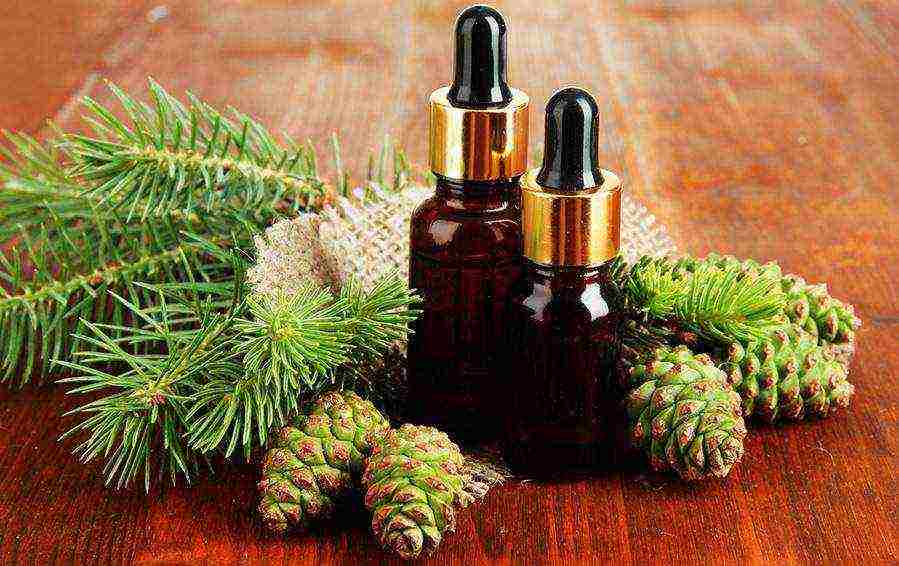 Fir oil
Fir oil
How to use fir essential oil
- Inhalation. 1-2 drops into hot water, inhale for 3-5 minutes.
- Aroma lamps. For 20 m2, 4-5 drops are used.
- Lotions and compresses. For 30 ml of warm water, 15 drops of oil, a napkin soaked in a solution is applied to the sore spot.
- Baths. 5-9 drops are mixed with sea salt.
- Rubbing. For 1 tbsp. any oil 5-8 drops of fir oil.
- Rinses. For 1 cup of water, 1-2 drops of oil.
- Additive. Add 1-2 drops to any face or hand cream, this will improve the condition of the skin. 2-4 drops of oil added to the shampoo strengthen the hair, preventing hair loss.
- Ingestion. 1-2 drops per 1 tsp honey.
- Air freshener.A 0.5 L spray bottle requires 40-50 drops.
Join the discussion!
We would be interested to know your point of view, leave your opinion
in comments
😼
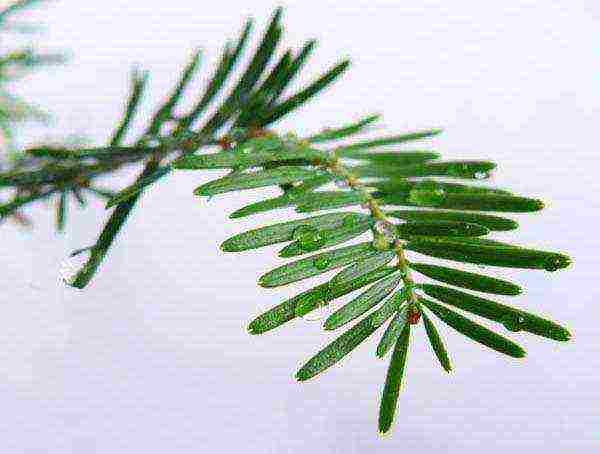
I love fir very much and, using the example of white fir, I will show you how to sow and grow them to a size that will allow you to plant seedlings in open ground without loss.
In fact, everything is simple!
In general, the sowing of fir is not much different from the sowing of spruce, but there are some peculiarities.
First of all, you need to get the seeds, which is logical. They can be bought, if available, or collected personally. If everything is very clear with the purchase, then there is one nuance with the collection of seeds.
Fir cones, unlike other conifers (except for real cedars, such as Lebanese), open after ripening, the contents are carried away by the wind. Their plus is that if you need to get seeds, you don't have to climb a 30-meter tree to pick cones, as you have to do in the case of spruce or pine. It is enough to wander under the firs at a time when they are crumbling (in our country it is mid-October), enthusiasts can climb a tree. The downside is that if there are only 1-2 fir trees and a strong wind is blowing, you may not find anything ...
What to do next? We read:
Seeds and remains of fir cones
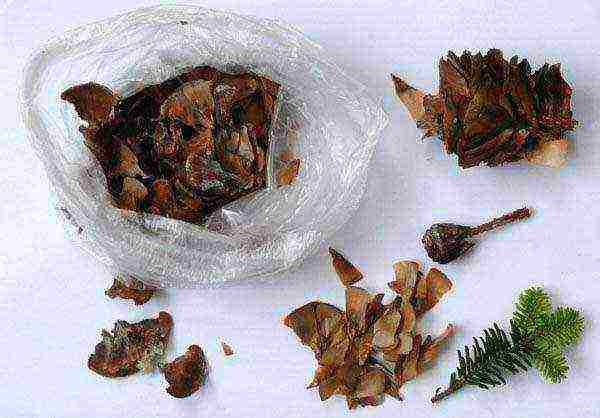
Place DRY seeds in a bag and refrigerate until spring. The temperature is about +5.
You can also put on stratification (in wet sand / perlite) so that they sprout more amicably, but there is no real need for this - fir seeds do not need stratification.
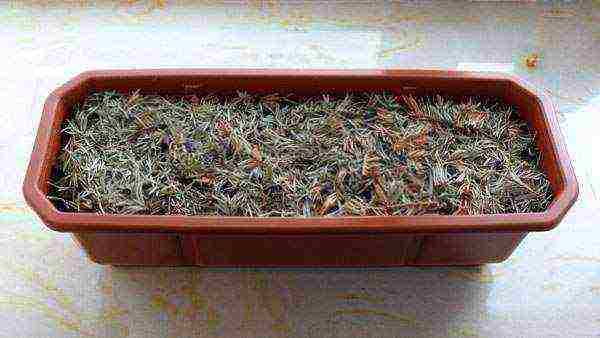
If the seeds have been stratified, then somewhere from the 7th day after sowing, the fir begins to sprout.
In the case of soaking, seedlings will appear 2-3 weeks later, but this is not critical

They are a month old and they will remain so until the end of the year. Fir trees grow by only 3-4 cm in the first year


Second year. The tallest is a pine tree, it is there by chance ...

The same fir, third year.
You can already plant in open ground, but still watch that the ground does not dry out on hot days

7 years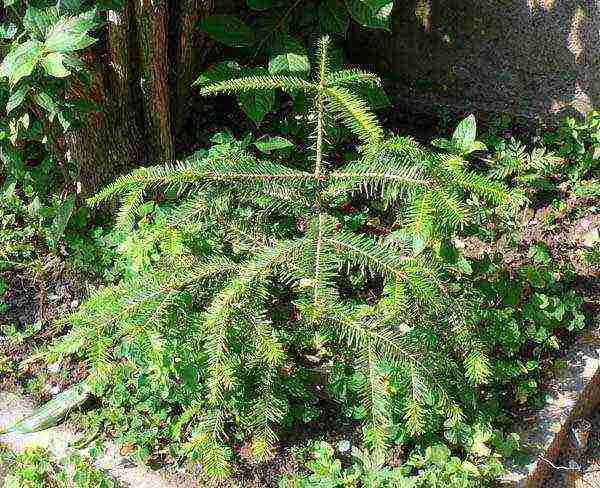
An evergreen tree, emitting a delicate coniferous aroma, can create an atmosphere of comfort and warmth in your home. Decorative fir in a pot looks very beautiful in any room. It would seem, what difficulties can arise when growing fir at home, because these trees grow well on the street? But if you want your plant to be healthy, beautiful and well-groomed, you must adhere to some rules for its maintenance.
General information
Fir is an evergreen tree native to the Caucasus and North America. Thanks to the variety of varieties, it has long become the favorite of many gardeners. If an ordinary tree growing on the street can reach eighty meters in height, then the height of the decorative species does not exceed two meters. At home, that is, in pots, they grow mainly Nordman fir (Danish), Fraser, gray, golden and erect. They differ in the color of the needles and the shape of the crown.
The lifespan of decorative fir varieties exceeds several centuries, and in the living environment the tree can grow up to eight hundred years! If a tree growing on the street adds up to 30 centimeters in height per year, then at home the fir grows much more slowly - no more than 4-6 centimeters per year.
Fir care
Caring for a fir at home begins with the correct selection of soil. The soil must be selected nutritious, slightly alkaline, with a neutral pH. Light soils and loams have these characteristics. Do not rush to immediately replant the fir that you purchased in the winter. First, the tree needs to get used to the temperature. If it was cold in the store where you purchased it, let the pot stand in the loggia or in the corridor for several days. An adapted plant can be placed anywhere in the house, since the fir tolerates direct sunlight and partial shade well.
Be sure to take care of good drainage and a sump, as the fir loves high humidity, and stagnant water is detrimental to its root system. It is necessary to water the tree at the root, and the crown should be sprayed several times a week. In hot weather, sprinkling under a shower with cool water will not hurt. During the first two years after planting the fir, the plant does not need additional fertilizing. Grown trees can be fertilized with granular fertilizers for conifers. An excellent result is given by top dressing with a Kemir universal.
The crown of decorative firs is formed independently, but if you want to change its shape, then pruning should be done in the spring. In addition, pruning allows you to control the height of the tree. But it is necessary to transplant decorative fir into new larger pots every two to three years. It is recommended to do this in April or September-October, that is, before or after a period of active growth. In order for the plant to adapt faster, the clod of its native soil should not be removed from the roots, and immediately after transplantation, it is worth fertilizing the soil with prolonged-action drugs. Make sure that after transplanting into a new pot, the fir root collar is at ground level.
Pest and disease control
Despite the undemanding care, decorative firs are susceptible to a number of diseases. If you overdo it with soil moisture, then fungus may develop. A plant affected by this disease must be treated with a 1% solution of copper sulfate and transplanted into a new substrate. In the future, water the fir less abundantly.
Ornamental firs are often attacked by pine cone moths, bark and shoot moths. Treatment with pesticides will help from this scourge. To prevent the pests from returning, preventive spraying should be carried out in the spring.
home
»
Fir
»
Growing fir from seeds at home
Features of growing balsamic fir in the garden
Similar articles
All About Planting Balsam Fir
Caring for Korean fir consists in maintaining a sufficient level of moisture and acidity of the soil nutrient layer. Fir should be watered regularly - 2-3 times per season will be enough. If there is a drought for a very long time, then it is advisable to spray the plant at least twice a week. If it does not receive enough water, then its roots will begin to dry out and it will die. Watering Korean spruce at the beginning of the day or late in the evening, as in this case, the water does not evaporate.
It is an evergreen and durable tree from the fir family. Originally from the south of the Korean Peninsula, from where it got its name. The Korean fir grows in a pyramidal (conical) shape. A tree sometimes even lives up to 150 years. Under natural conditions, it grows in large quantities in the Northern Hemisphere, on the territory of South Korea. Korean fir is almost not a thorny plant and for this quality it is appreciated by landscape designers and collectors of conifers. Its growth is much slower than that of the spruce. This circumstance does not allow landscaping the territory with the help of Korean fir in a short time. The only way out is to buy an adult plant with transportation and planting on the site. This is a rather expensive pleasure. But the beautiful appearance of the Korean fir justifies any expense.
Fir seeds need to be stratified for at least 30-40 days. You can put them in wet sand or put them in a plastic bag and - in the cold. Sow preferably in spring. Dry seeds should be soaked the day before. Substrate - compost, sand, rotted sawdust (3: 1: 0.5). Crops can be mulched with fir litter to preserve moisture. If sufficient moisture is maintained, sprouts begin to appear on the 7-10th day. In the first 10 years of life, fir grows very slowly. It is better to transplant them into open ground for 4-5 years of life.
- In a simplified version, you can plant seeds simply in sandy-sod soil to a depth of 2 cm. Note that in this case, it is better not to water the garden bed from above, so that a crust does not form.
- More information about the beneficial properties of fir can be found by watching the video.
- It is undesirable to transfer future crops directly from cold to warm.
- With the onset of spring, it is required to process the shoots by removing the dried branches. It is necessary to give the tree crowns a graceful shape only in the spring. In the first year after planting, the plant is covered with spruce branches for the winter. The more mature the plant is, the less it will need protection from frost. In general, the plant is unpretentious in care, however, it is still recommended to adhere to certain rules.
- Sand
The next layer is added fertilizer of mineral origin.
The dwarf variety Hudsonia has a wide crown and dense branches. This variety has a black-green top and a bluish-green bottom. The needles are short, but wide and slightly flat.
Balsam fir belongs to the pine family and belongs to evergreen conifers. You can recognize such a plant by the needles, which are protruding, spreads in different directions and has a clear parting. The root system is strong and spreads to the surface. Therefore, a hot southern climate is not suitable for this plant. The plant will feel more comfortable in the mountains and lowlands. It is a very shade-loving plant and with proper care can live up to 150-200 years.
If you live in an urban area, then the cultivation of this type of fir can cause some problems, since it does not tolerate pollution of its environment. At the same time, the tree is resistant to winds due to its branched root system.
- The plant has the following description: leaves are needle-like, flat, 1-2 cm long and 2-2.5 mm. 0.5 mm. thick, glossy greenish tint above, and with two wide, bright white stripes below, slightly serrated at the tip. Korean fir cones can be blue to purple in color. Their size is 4-7 cm long and up to 2 cm wide.
- High-quality firs are propagated vegetatively to preserve all maternal traits. The easiest way is layering. The lower branches of fir can give roots when in contact with the soil, even without the direct involvement of the gardener. Rooting takes place within 1-2 years. However, with this method of reproduction, the conical shape of the crown is not guaranteed.
- The greenhouse is covered with frames or foil; on the open ground, tents made of non-woven material or cotton fabric are used to protect the seedlings from direct sunlight. In both cases, in mid-August, the covering material must be removed, and closer to winter, the plants must be covered with dry leaves.
Species firs are more often grown from seeds, and decorative forms created by breeders are usually propagated by grafting or from cuttings so that they do not lose their decorative qualities.
- It is necessary to gradually increase the temperature so that the plant adapts to new conditions.
- The plant propagates with the help of seeds.
- The plant is planted, in most cases, in alleys at an optimal distance of 4-5 meters. In looser soils, it can be planted at a distance of 3-3.5 meters, and in more compacted soils up to 2.5 meters. Planting of plants must be carried out in the spring season - April or in August or at the beginning of the autumn period. The seedlings planted at the age of 5-10 years adapt as quickly as possible.
- The last layer is added sawdust.
- Many gardeners prefer a fir variety like Nana. This variety boasts a height of up to 50 cm and a rounded shape. Possesses high shade tolerance and frost resistance. Ideal for a rocky garden, but will also feel great in special containers.
Outwardly, the plant has a powerful pyramidal shape with a low crown, which in old trees can have a rounded or bipartite shape. The bark has a grayish tint, periodically there are veins with resin. The branches are located obliquely and directed upward, however, there is also a horizontal direction. The plant grows 15-25 centimeters annually. However, it grows much more slowly at home.
The plant does not require pruning, as the crown of the Korean fir is formed independently. Primary pruning can be done only to help develop any desired shapes and to extract dead, diseased, or dying scions from them.
The Korean fir tree is very hardy and grows well both in the sun and in partial shade, but it develops best when the sun's rays fall on it. Thus, her crown becomes fuller and more attractive. This tree grows slowly, on average 3-5 cm per year. Fir of this species grows up to 10-18 meters in height with a trunk diameter of up to 0.7 meters. Its bark is smooth, gray-brown in color. The branches are arranged in a tier form. Look at the photo of Korean fir and appreciate its beauty:
Fir care
When fir cuttings propagate, the roots appear at 8-9 months. You need to use only twigs of the last year of life and take them preferably from old plants in early spring at the very beginning of bud awakening. The bottom of the cuttings is cleaned of needles, immersed for several hours in a weak solution of potassium permanganate. They are planted at an inclination of 30 degrees, deepening by 2-3 cm. The simplest version of the soil mixture is compost and sand (2: 1). It is very important to maintain sufficient air humidity.
When growing seedlings, the soil is kept in a moderately moist state. The volume and frequency of watering is increased only in the heat. Excessive waterlogging can cause rotting of seeds, so shelters or greenhouses are recommended to be periodically ventilated.
The harvesting of seeds is carried out when the ripening of the cones is just beginning - they must be slightly ripe so that the seeds do not fall off along with the scales. The collected cones are dried and the seeds are removed.
When choosing a fir for reproduction, it is necessary to correctly select a variety. In the middle zone of our country, white fir very often freezes out. And dwarf varieties are more resistant to frost. Fir prefers a maritime climate, since there is no sharp fluctuation in temperature and humidity.
Breeding features
The seeds are harvested at the beginning of the ripening of the buds. Seeds are planted in autumn or winter, after the seeds are finally prepared and lay in the harvested state for 30-40 days. Typically, seeds are stored at room temperature for one year.
When planting a plant, due attention must be paid to the depth of the holes.
The composition of the soil is carefully selected and includes the following components:
Thus, fir is excellent for landscaping the backyard landscape, and a huge number of species presented will allow you to choose any style solution.
Cones "male" are located in the sinuses in a single way. "Female" cones have a vertical arrangement and include seeds and scales. When the seeds reach their maturity, the bud loses its scales, leaving the skeleton on the branch. When ripe, the bud takes on a beautiful purple hue. If you rub a branch of a tree, then a pleasant and fragrant aroma will remain on the palms.
- It is best to plant Korean fir in April or September. She tolerates transplanting well both in the spring and in the summer. The most important thing is that the clod of earth around its roots is not disturbed. Best of all, seedlings aged 5-10 years take root in a new place.
- Korean fir is propagated by seeds and cuttings, depending on the climatic conditions of growth.On the territory of our country, zoned cultivation with the help of seeds and hardening is recommended already at the stage of growing seedlings. Korean fir seeds can be purchased at specialized centers. At the initial stage, the cultivation of seedlings can be carried out in indoor conditions and greenhouses. Korean firs are often used as a decoration for the Christmas holidays as well as to decorate the landscape. The tree does not take up a lot of space, therefore, it does not push back other plants and trees standing next to it.
- The best time to plant is April or August-September. Container plants can be transferred outdoors throughout the growing season. The ideal planting material is 5-10 year old seedlings. A place for a fir should not be chosen in the sun, it is quite shade-tolerant.
- The seedlings are fed three times over the summer using a 0.1% hydroponic solution or mullein diluted with water 1: 5. Top dressing is combined with watering.
You can plant seeds in the fall, but it is better to keep them in a cool, dry place until next spring. In March, before planting, it is advisable to subject the seeds to monthly stratification by placing them in a cold place - this will accelerate their germination. Previously, the seeds must be dipped for half an hour in a 0.5% solution of potassium permanganate, then rinsed with clean water and soaked for swelling for a day. After that, they are placed in nylon bags filled with wet sand and, before sowing (usually for a month), are placed in a snow pile or refrigerator.
On the garden plot, fir decorates the local landscape. In order to propagate a plant on your own, you need to know certain tricks, otherwise the summer cottage will not be decorated with a similar decorative element. Do not forget to carefully study the tree for the presence of pests and fight them in a timely manner. Fir cultivation does not involve high costs and excessive physical effort.
Plant properties
Also, reproduction can be carried out using perennial cuttings, which are removed from the top of the plant.
It should not be more or less than 60-80 cm. When making a hole, it is important to focus on the size of the coma on the root system. In total, the landing pit should have dimensions of 50x50 or 50x60. When immersing the plant in the hole, you should carefully make sure that the root collar is at ground level.
Clay
When planting fir, it is necessary to take into account the qualitative composition of the fir.
In nature, there are about 20 varieties of such a plant, among them cultivated and wild varieties are distinguished:
An adult Korean fir is considered 15 years later. For the first 10-15 years the tree grows at a very slow rate, and then the rate of its growth increases and per year it can grow by 30-50 cm. So, if the fir is 30 years old, then it can reach up to 10 meters in length.
Fir propagation - seed preparation
Before you start planting Korean fir, you should dig a small hole 60x60 cm. It is recommended to leave the neck of the root system of the plant at the same level with the soil during planting.
The planting hole (about 50 × 50 cm) and the soil mixture with which we will then fill it, it is advisable to prepare it in a few days. Soil mixture - clay, leafy earth or humus, peat, sand (2: 3: 1: 1). Another option is loam and humus (2: 1). On heavy soils, drainage should be placed on the bottom with a layer of 15-20 cm. Planting depth is 60-80 cm. The root collar should be left at ground level.
A cute coniferous fir tree with cones growing vertically on its legs, similar to New Year's toys, is a real decoration of the site, especially on the eve of the winter holidays.
You can limit yourself to soaking for 2-3 weeks in cold water to check the quality and swelling.
Growing fir from seeds
The fir tree has a huge number of beneficial properties.Firstly, fir oil is obtained from it, which has a beneficial effect on the respiratory organs and is used as an inhalation agent. The scent of fir helps people with respiratory diseases to cope with their ailment.
However, the roots of cuttings germinate after eight or nine months. Crown formation occurs naturally. At first, the plant develops rather slowly, but after 5-10 years, growth is noticeably accelerated, and reaching adulthood it grows again slowly. When the branches of the fir touch the soil, they produce layering.
In order for the plant to please for a long time with its appearance, it needs additional care. Having counted two years after the moment of planting, it is necessary to apply a universal mineral fertilizer. It is recommended to water the fir 2-3 times a season. The total volume of water for irrigation should be 15-20 liters. During dry periods, it is advisable to carry out periodic spraying every 2-3 weeks.
Leaf land
Watering and feeding
The plant loves moist and loose soil.
The most popular among gardeners is the dwarf fir variety. Such a plant has a bizarre flat-round shape. The bright emerald color of the plant with gentle open branches is an excellent decoration for any garden area.
Young plants are advised to feed in the process of caring for Korean fir, and fertilization is not required for adults.
Simultaneously with the planting of Korean fir, agronomists advise to mulch the area near the trunk with sawdust or peat. In this case, the height of the mulch layer should be at least 5-8 cm. This is useful so that the young plant does not suffer from severe frosts. In adult plants, frost resistance is higher, therefore, it is not necessary to cover the peri-stem region. It is also recommended to pre-make drainage from bricks or rubble.
Fir trees are quite undemanding, but they prefer rich, moist and well-drained soil. They do not like excessive dryness of both air and soil. It is necessary to water at least the first 5-10 years regularly enough, then the plant will form a powerful deep root and will be able to extract a sufficient amount of moisture by itself. The first 2-3 years need to be fed with a special fertilizer for conifers, then - at will. The fact is that the fir accumulates a layer of coniferous litter under the crown, which serves as both fertilizing and mulch. It is not necessary to remove it! Fir is quite winter-hardy, but it is still advisable to cover young plants with spruce branches so that they are not damaged by recurrent spring frosts.
- Cones ripen in the year the fir blossoms. And it comes once every 1-3 years (depending on the age of the plant and the species). In autumn or winter, the fruits open up, releasing seeds-nuts. You can collect them and try to grow new fir trees.
Fir seed
Such preparation is not necessary, especially if you have a sufficient number of seeds - seedlings that have appeared without preliminary seed treatment will be enough.
Fir vegetative propagation
This remedy calms the nervous system. Such a plant is indispensable for coughs, runny nose, contributing to the optimal discharge of sputum. Balsamic fir is the main component of Canadian balsam. Fir resin is a powerful antiseptic.
Fir seeds require additional stratification:
Landing
Do not overuse watering, as the soil does not tolerate excessive moisture.
Humus
Care
Especially if the soil is heavy, you need to take care of the drainage, which is made as follows:
Another variety of such a plant, "Piccolo", is very similar in shape to such a variety. However, it has a bluish color with a green tint and the branches are arranged in a radial manner and slightly deviated downward.
Quite successful reproduction of this tree is possible by collecting seeds from cones. Korean fir seeds have a high germination rate. Planting Korean fir seeds should be carried out in the autumn or spring after the seeds have been kept at a certain temperature for a month.
If in the area where the Korean fir grows very severe frosts are observed, and in the spring from time to time there are recurrent frosts, then under any circumstances you should cover the young plant with an additional bedding of branches of evergreen trees (spruce, pine). You need to cover the tree in full length, this event is especially important in the first year after planting - otherwise it will entail negative consequences. The Korean fir tree will freeze, as evidenced by the blood-red tint of the needles.
Description of Korean fir and its photo
By the way, it should be borne in mind that the branches of the fir itself should not be used to shelter garden plants. In the spring, a lot of needles remain on them, which does not allow light or fresh air to pass through, which in early spring can be fatal for the covered plants.
Table of Contents
Seeds are sown from the second decade of April. The soil should be sandy loam and loose, a layer of sawdust (2 cm thick) is poured on it. Seeds are spread on the first layer of sawdust, and sprinkled on top with another layer 1-1.5 cm thick (fresh coniferous sawdust is used for it) and watered abundantly.
Planting and caring for Korean fir
With this tool, you can disinfect a wound, treat cuts and abrasions.
This procedure consists in keeping the seeds in a moist substrate.
Young seedlings must be loosened, keeping a distance of 25-30 cm. From time to time, it is important to mulch the ground with sawdust, peat near the trunk circles at a distance of 5-8 centimeters.
Peat
Crushed stone 20 centimeters deep or broken brick is poured into the dug hole.
Another dwarf species with bluish-green needles called "Kiwi" will undoubtedly become the main decorative element of the garden.
You can propagate Korean fir and annual cuttings, with the conditions that they will have a kidney on top. A more efficient way, but again not so simple. Germination is carried out without fail at a temperature of 18 to 23 degrees Celsius and with moderate watering.
Sour or neutral soil favorably affects the development of Korean fir. Before planting Korean fir, you need to make sure your tree will sit in a location where the soil is sufficiently moist.
Dmitry Kizulev, village Stanichki, Smolensk region
4 Care
Korean fir seeds and planting
The sowing site in the open field should be covered with a layer of twigs so that rain and wind do not wash away and blow off the sawdust.
Such a plant is indispensable in garden and park construction, as it boasts a lush and graceful shape and a noble color of shiny greenery. However, in an urban environment, they feel discomfort from the abundance of polluted air. Fir goes well with other trees of the middle lane - maples, birches, pines and all kinds of shrubs. Ideal for shearing hedges.
Sand or perlite can be used as a wet substrate.


